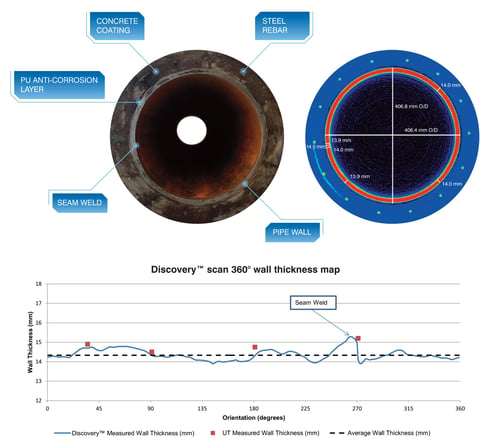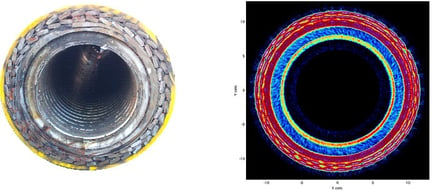In this blog post we will discuss the top five questions we are asked with regard to our subsea technologies, Discovery™ and Explorer™.
It won't work for concrete coated subsea pipeline. Will it?
Yes. It absolutely will work on concrete coated subsea pipelines. We recently completed a job in the North Sea for a life extension project. An image of the trial scan is shown below. If you would like to arrange a blind test of a concrete wrapped pipe section at one of our state-of-the-art test centres located in Houston, Texas or Billingham, UK please sign up here.

In the presentation, a reference was made to flexibles. Is this specific to flexible flowlines or flexible risers? If flexible flowlines can be inspected, can you please provide more information on your experience with inspecting flexible flowlines?
Flexible flow lines and flexible risers can both be inspected using Discovery™ technology. (See scan example below). Discovery™ can be operated in both horizontal and vertical positions. With regard to flexible flowlines 360o access to the line is required and therefore flexible risers are much quicker to inspect. If you would like to arrange a blind test of a section of flexible flowline or risers at one of our state-of-the-art test centres located in Houston, Texas or Billingham, UK please sign up here.

How accurately can the type and nature of deposits be determined?
Various types of restriction can be identified and Discovery™ can distinguish between wax, asphaltene, hydrate, sand and scale. The type, formation and amount of each of these can all be individually determined and characterised. The detection rate is down to 0.05g/cc.
Is the 1mm resolution the same for any pipe diameter or is it a function of it?
Close to 1mm resolution can be obtained regardless of the pipe diameter. This is because it is an actual physical measurement and not a function of the diameter of the pipeline.
What is the inspection speed for the Discovery™ and the Explorer™? What is the support required: DP vessel, Rov, Divers, etc.?
A DP vessel is required together with either an ROV or team of divers. Inspection speed varies according to what is being investigated. Explorer™ has been designed as a screening tool and is therefore much faster than Discovery™. Typically, you would screen using Explorer™ to identify areas for further investigation by Discovery™ as Explorer™ data is limited to a mean density of contents and therefore it can’t provide information on the structure or the nature of the restrictions.
To learn more you can log in to watch or download a full list of the questions and answers from our webcast 'Revolutionise your approach to subsea pipeline inspection and save on costs versus conventional scanning techniques'.

